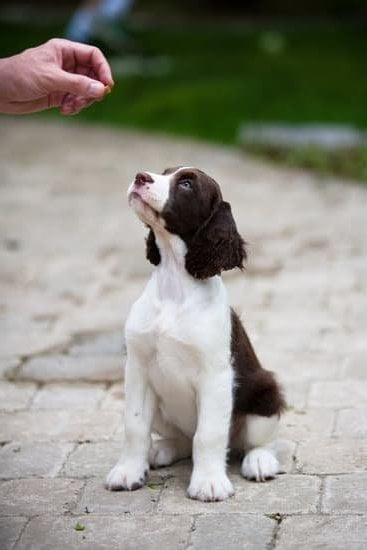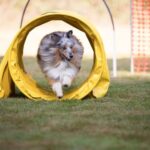Training your dog to hunt shed antlers is not only a thrilling adventure, but it also serves a practical purpose. Shed hunting, the search for naturally fallen deer antlers, has gained popularity among both hunters and outdoor enthusiasts. Not only does it provide valuable information about local deer populations, but it also presents an opportunity to spend quality time with your four-legged companion.
In this comprehensive guide, we will explore the essential steps and techniques that will help you train your dog to become a skilled shed antler hunter. From understanding the difference between traditional hunting and shed hunting to troubleshooting common challenges, we will cover every aspect of this rewarding endeavor.
Before diving into training techniques and strategies, it is crucial to assess your dog’s natural abilities and choose the right breed and age suitable for shed hunting. Additionally, building a strong foundation through basic obedience training and impulse control will set the stage for more advanced tasks in later stages of training.
By following our step-by-step instructions, you will learn how to introduce scent cues to your dog, develop tracking skills for locating antlers in various terrains and weather conditions, maintain their drive and motivation throughout the training process, ensure their safety when navigating obstacles or hazardous areas, and overcome any challenges that may arise along the way.
Embark on this exciting journey with your furry friend as we guide you through the art of training your dog to hunt shed antlers – an endeavor that promises not only successful hunts but also deepened bonds between you and your loyal companion.
Understanding the Difference between Shed Hunting and Traditional Hunting
Traditional hunting and shed hunting may share similarities, but there are key differences between the two activities. Shed hunting involves searching for antlers that have naturally fallen off deer, elk, or other antlered animals. On the other hand, traditional hunting typically focuses on pursuing and harvesting live animals.
One important distinction between shed hunting and traditional hunting is the objective. In traditional hunting, the goal is to harvest an animal for its meat or other resources. In shed hunting, the objective is to locate shed antlers as a recreational activity or for collecting purposes. Shed hunters often enjoy the challenge of finding antlers and may use them for various purposes such as home decor or crafts.
Another difference is the time of year when these activities occur. Traditional hunting typically takes place during designated seasons when it is legal to hunt specific game species. Shed hunting, however, usually occurs in the offseason when antlers have naturally dropped and animals are not being pursued for their meat. This gives individuals an opportunity to explore nature and spend time outdoors during a different time of year.
Understanding these differences is crucial when training your dog to hunt shed antlers. While some skills may overlap between traditional hunting and shed hunting, it is important to tailor your dog’s training specifically for finding shed antlers. It requires teaching them to locate and retrieve antlers without being distracted by live game or scent trails left by animals.
| Traditional Hunting | Shed Hunting |
|---|---|
| Objective: Harvesting live animals for meat or resources. | Objective: Locating shed antlers as a recreational activity or for collecting purposes. |
| Time of Year: Typically occurs during designated seasons. | Time of Year: Usually takes place in the offseason when antlers have naturally dropped. |
| Focus: Pursuing live game animals and tracking their movements. | Focus: Locating shed antlers and developing skills in scent detection and retrieval. |
Assessing Your Dog’s Natural Abilities
When it comes to training your dog to hunt shed antlers, it’s important to start by assessing their natural abilities. Not all breeds are well-suited for this task, so choosing the right breed and age is crucial for success. Here are some considerations to keep in mind:
- Breed selection: Certain dog breeds have a natural instinct for hunting and retrieving, making them ideal for shed hunting. Breeds such as Labrador Retrievers, German Shorthaired Pointers, and English Setters have a strong drive and excellent scent detection abilities that can be honed for shed hunting. However, it’s important to note that any breed can be trained for this activity with the right approach and motivation.
- Age: While there is no definitive age limit for starting shed hunting training, it’s generally recommended to start when your dog is at least six months old. At this age, they have developed enough physically and mentally to handle basic obedience training exercises. Starting too early may overwhelm young puppies or lead to injuries since their bones are still growing.
Once you have chosen the right breed and age for your shed hunting endeavor, it’s time to assess your dog’s individual temperament and personality traits. Some dogs may naturally display more enthusiasm or persistence in searching activities than others. This assessment will help you understand your dog’s strengths and weaknesses better, allowing you to tailor your training methods accordingly.
Remember that every dog is unique, and it may take some trial and error to find the best approach that suits both you and your canine companion. Patience, consistency, and positive reinforcement will be key throughout the training process.
To build a strong bond between you and your dog during shed hunting training, it’s crucial to establish a foundation of basic obedience skills and impulse control. This sets the stage for more advanced training techniques later on in the process. The next section will delve into the importance of basic obedience training and how it contributes to your dog’s success as a shed hunter.
Building a Strong Foundation
Building a strong foundation in basic obedience training and impulse control is crucial when training your dog to hunt shed antlers. This section will discuss the importance of these skills and provide tips on how to develop them in your dog.
Basic obedience training is the starting point for any successful hunting dog. Teaching your dog commands such as sit, stay, come, and heel not only reinforces your role as the leader, but also ensures that they have the necessary discipline and control to be safe and effective in the field.
Consistency and positive reinforcement are key when training these commands. Use treats or praise to reward your dog for following instructions, and be patient as it may take time for them to understand what you are asking of them.
Impulse control is another vital skill that will benefit your dog during shed hunting. Dogs with good impulse control are able to remain calm and focused in high-stress situations, which is important when working around distractions or encountering wildlife during hunts. To develop this skill, start by teaching your dog to wait for their food or treats until given permission.
Gradually increase the duration of their wait time before rewarding them. This exercise helps teach your dog self-control and patience.
Another useful exercise for improving impulse control is teaching your dog to “leave it.” Start by showing them a treat in closed fist and say “leave it.”
If they attempt to get the treat out of your hand, close it tighter until they back off even slightly. As soon as they leave it alone even slightly-click with a clicker or use some other way of marking that moment-and then open fist so they can see that leaving it gets rewarded.
By building a strong foundation in basic obedience training and impulse control, you are setting your dog up for success in shed hunting. These skills will not only make them more obedient and manageable in the field but also help ensure their safety and enhance their potential as a reliable hunting companion.
| Basic Obedience Training | Impulse Control |
|---|---|
| Teach commands such as sit, stay, come, and heel | Teach your dog to wait for their food or treats until given permission |
| Use positive reinforcement and be consistent | Increase duration of wait time before rewarding |
| Reinforce your role as the leader | Teach “leave it” by gradually increasing difficulty |
Introducing Scent
Training your dog to hunt shed antlers involves teaching them to recognize and follow the scent of these natural treasures. Introducing scent is an essential step in the training process, as it helps dogs develop the ability to differentiate between various smells and identify the specific scent of shed antlers.
One effective way to introduce scent is by using shed antler training aids. These aids are typically made with a synthetic substance that mimics the smell of real shed antlers. Start by allowing your dog to inspect and sniff the training aid, associating it with a positive experience such as play or treats. Gradually increase the difficulty by hiding the training aid in different locations, encouraging your dog to use their nose to locate it.
Another method for introducing scent is through scent imprinting. This involves rubbing an actual shed antler on various objects such as towels or socks, then placing those scented objects in a controlled training environment for your dog to find. Through repeated exposure, your dog will learn to associate the smell of shed antlers with locating hidden objects.
It’s important to be patient during this process, as each dog learns at their own pace. Some may quickly pick up on the scent while others may require more time and repetition. Remain consistent in your training methods and always reward your dog when they successfully locate or indicate the presence of a shed antler scent. With time and practice, your dog will become proficient in recognizing and following the smell of shed antlers.
| Training Method | Description |
|---|---|
| Shed Antler Training Aids | Using synthetic substances that mimic the smell of real shed antlers. |
| Scent Imprinting | Rubbing an actual shed antler on various objects to create a scent, then hiding them for the dog to find. |
Tracking and Retrieving
Tracking and retrieving are crucial skills for a dog that is being trained to hunt shed antlers. These skills not only enable the dog to locate and bring back the shed antler, but they also build confidence in the dog’s hunting abilities. This section will provide guidance on how to develop tracking skills in your dog and help them become confident hunters.
Start with Basic Tracking Exercises
Begin by teaching your dog basic tracking exercises to familiarize them with the process of following a scent trail. Start with short trails using a familiar scent, such as treats or toys, and gradually increase the difficulty by lengthening the trail and introducing different scents. Use positive reinforcement techniques like treats and praise to reward your dog for successfully following the trail.
Introduce Shed Antler Scents
Once your dog has mastered basic tracking exercises, it’s time to introduce the scent of shed antlers. Begin by rubbing a shed antler on a towel or cloth and placing it along the trail during tracking exercises. As your dog becomes more proficient at following the scent, gradually decrease the visibility of the antler until they are able to track it without any visual cues.
Encourage Retrieval Skills
In addition to tracking, retrieving is another essential skill for shed hunting dogs. Teach your dog basic retrieval commands like “fetch” or “bring,” and gradually associate these commands with shedding tasks. Start with simple retrieves using toys or objects resembling shed antlers, and progressively transition to actual shed antlers.
As your dog becomes more confident in their tracking and retrieving abilities, continue to challenge them by introducing different terrains and weather conditions. This will help them adapt to various hunting scenarios they may encounter during shed hunting expeditions.
By focusing on developing strong tracking skills and building confidence in your dog’s ability to retrieve shed antlers, you are setting them up for success as a shed hunting companion. Stay patient, provide consistent training, and always keep the sessions fun and enjoyable for both you and your dog. With practice and dedication, your dog will become a skilled shed antler hunter that you can rely on in the field.
Advanced Training Techniques
In order to fully prepare your dog for shed hunting, it is important to train them in various terrains and weather conditions. This section will provide you with advanced training techniques to help your dog navigate different environments and overcome challenges they may encounter during the hunt.
One technique to incorporate into your training is simulating different terrains. This can be done by setting up training scenarios in various locations such as fields, forests, and even bodies of water if your dog is comfortable swimming. By exposing your dog to different types of terrain, they will learn how to navigate obstacles and search for shed antlers effectively in any environment. Start with familiar terrains and gradually introduce new ones as your dog progresses in their training.
Another aspect of advanced training is teaching your dog how to work in different weather conditions. Shed hunting can take place in a variety of weather situations, so it is vital that your dog remains focused regardless of the elements.
Training sessions should be conducted in rain, wind, snow, and other adverse weather conditions to acclimate your dog to these situations. This will ensure that they stay on track and continue searching for shed antlers even when faced with challenging weather conditions.
To further enhance the advanced training process, consider creating scent trails in various terrains and weather conditions. Start by placing a shed antler at desired locations while marking them with scents or oils that mimic the natural smell of deer. Gradually increase the difficulty level by extending the trail length or hiding the antlers in more challenging spots. This type of exercise will sharpen your dog’s scent detection skills while giving them experience working in different environments.
By incorporating advanced training techniques into your shed hunting program, you are giving your dog the tools they need to succeed in any terrain or weather condition. Through exposure and practice, they will become confident hunters capable of locating shed antlers no matter the circumstances. Keep these techniques in mind as you continue to develop your dog’s skills and enjoy the rewarding experience of shed hunting together.
Maintaining the Drive
One of the key factors in successfully training your dog to hunt shed antlers is maintaining their drive and motivation. This section will discuss some important strategies for keeping your dog engaged and excited about shed hunting.
Variety in Training
To keep your dog motivated, it’s crucial to provide them with a variety of training scenarios. Dogs thrive on novelty and new challenges, so try to switch things up during your training sessions. This can include training in different locations, such as forests, fields, or even urban areas. Additionally, vary the difficulty level by incorporating different obstacles or distractions for your dog to navigate while searching for shed antlers.
Another way to add variety is by utilizing different types of terrain. Train your dog in various environments like thick brush, tall grass, or even bodies of water if they are comfortable with swimming. By exposing your dog to different terrains and weather conditions, you’ll help them develop adaptability and confidence in any situation they may encounter during an actual shed hunting expedition.
Rewards and Reinforcement
Reward-based training is essential for maintaining your dog’s motivation. When they successfully find a shed antler, make sure to offer plenty of praise, treats, or their favorite toy as a reward. The anticipation of receiving rewards will keep them eager and focused during each training session.
It’s important to note that starving your dog before a search in the hopes of increasing motivation through hunger is not recommended. This can lead to unhealthy behaviors and a decrease in focus as their energy levels are depleted. Instead, implement consistent reward-based systems that help maintain their enthusiasm without compromising their overall wellbeing.
Consistency and Progression
Consistency is key when maintaining your dog’s drive for shed hunting. Set aside regular training sessions that are tailored specifically for this skillset. If you skip too many sessions or have long breaks between training days, your dog may lose interest and motivation.
As your dog becomes more proficient in the basics of shed hunting, it’s important to gradually increase the difficulty level of the training. This can be done by hiding the shed antlers in more challenging locations or by increasing the distance between hiding spots. Progression keeps your dog engaged and prevents them from becoming bored with repetitive tasks.
By consistently providing variety in training, rewarding your dog for their efforts, and gradually increasing the difficulty level, you’ll be able to maintain their drive and keep them motivated and engaged in shed hunting. Remember, a motivated and excited dog is more likely to excel at the task at hand.
Safety Considerations
Training your dog to hunt shed antlers can be an exciting and rewarding experience. However, it is important to prioritize safety throughout the training process to ensure the well-being of both your dog and yourself. In this section, we will discuss some important safety considerations when training your dog to avoid hazards and obstacles during shed hunting.
Assessing the Terrain
Before heading out for a shed hunting session with your dog, it is crucial to assess the terrain you will be exploring. Take note of any potential hazards or obstacles such as steep slopes, dense vegetation, bodies of water, or rough terrain that could pose a risk to you or your dog’s safety. It may be helpful to familiarize yourself with the area beforehand and create a mental map of the potential dangers.
Training Recall and Stay Commands
One of the most essential safety measures when training your dog for shed hunting is ensuring they have a strong recall command. This means that when called, your dog should immediately come back to you regardless of distractions or temptations in the environment. Practice reinforcing this command in controlled environments before progressing to more challenging outdoor settings.
Additionally, teaching your dog a reliable stay command can help prevent them from venturing into hazardous areas unsupervised. This command allows you to keep them in place when encountering potentially dangerous situations such as cliffs, roads, or thick brush.
Using Protective Gear
Investing in appropriate protective gear for both you and your dog can help minimize potential injuries during shed hunting sessions. Consider equipping yourself with sturdy hiking boots, long pants, and comfortable clothing that protects against scratches from vegetation or sharp objects on the ground.
For your furry companion, consider outfitting them with a reflective vest and/or a GPS tracking collar. These precautions will not only help locate them if they get lost but also increase their visibility during low light conditions or in areas with hunting activity.
Remember, safety should always be your top priority when training your dog to hunt shed antlers. By being aware of potential hazards, teaching crucial commands, and using protective gear, you can ensure a safe and enjoyable experience for both you and your four-legged partner in shed hunting adventures.
Troubleshooting
Training a dog to hunt shed antlers can be a rewarding experience, but it is not without its challenges. In this section, we will explore some common challenges that dog owners may encounter during the training process and provide strategies for overcoming them.
- Lack of Interest: One common challenge is when a dog shows little to no interest in shed hunting. This can be frustrating for owners who are eager to train their dogs in this skill. To overcome this challenge, it is important to make the training process fun and rewarding for your dog.
Use positive reinforcement techniques such as treats, praise, and play to build excitement and motivation. Start with short training sessions and gradually increase the duration as your dog becomes more engaged. - Difficulty in Focusing: Dogs have a natural inclination to explore their surroundings, which can make it challenging for them to stay focused on the task at hand. To address this challenge, practice impulse control exercises during basic obedience training.
Teach your dog commands such as “leave it” or “stay” to help them resist the urge to wander off or become distracted by other scents or objects. Consistency and patience are key when developing focus in your dog. - Overcoming Fear: Some dogs may exhibit fear or anxiety when introduced to new environments or stimuli during shed hunting training. This can hinder their progress and confidence in performing the tasks required of them. To overcome fear-related challenges, expose your dog gradually to new settings and sights associated with shed hunting.
Use positive reinforcement techniques and rewards to build trust and association with these environments. Consider seeking professional help from a trainer experienced in working with fearful dogs if needed.
In order to successfully navigate these common challenges, it is important for dog owners to remember that each dog is unique and may require different approaches or modifications in training methods. Patience, consistency, and positive reinforcement are essential throughout the troubleshooting process. With dedication and persistence, you can overcome these challenges and continue to progress in training your dog to hunt shed antlers.
Conclusion
In conclusion, training your dog to hunt shed antlers can be a rewarding and beneficial experience for both you and your furry companion. Not only does it tap into your dog’s natural instincts and provide mental and physical stimulation, but it also allows you to spend quality time together in the great outdoors.
By following the steps outlined in this guide, you can develop a strong foundation of obedience, scent recognition, tracking, and retrieving skills in your dog. These skills will not only enable them to excel in shed hunting but also enhance their overall behavior and responsiveness.
Training your dog to hunt shed antlers also offers practical benefits. Finding these discarded antlers can provide valuable insight into the local deer population, their health, and their patterns of movement. It can also be a rewarding hobby in itself, allowing for exciting discoveries and a deeper connection with nature.
Ultimately, the rewards of training your dog to hunt shed antlers extend far beyond the act itself. The bond forged between you and your four-legged partner will grow stronger as you work together towards a common goal. So why wait? Get started on this exciting journey and unleash the full potential of your pup today.
Frequently Asked Questions
How do I teach my dog to find shed antlers?
Teaching a dog to find shed antlers requires patience and consistent training. Start by introducing your dog to antlers by letting them sniff and explore them. Use positive reinforcement, such as treats or praise, when they show interest in the antlers.
Gradually transition to hiding the antler in easy-to-find locations and encourage your dog to search for it using commands like “find it” or “search.” As your dog becomes more comfortable with the process, increase the difficulty of hiding spots and slowly hide the antler in larger areas like fields or woods. Regular practice sessions will help reinforce their skills and improve their ability to find shed antlers.
Can you teach a dog to shed hunt?
Yes, you can definitely teach a dog to shed hunt! While certain breeds have a natural instinct for hunting or retrieving, any breed can be trained to become a successful shed hunter.
Some dogs may require more time and effort during training compared to others, but with consistent work and positive reinforcement, most dogs can learn this skill. It’s important to remember that each dog learns at its own pace, so be patient and tailor your training methods based on your dog’s individual needs.
What is the best dog for antler shed hunting?
The best type of dog for antler shed hunting depends on various factors such as personal preferences, specific needs, and hunting conditions. However, there are certain breeds that are often recognized as excellent for this activity due to their instincts and abilities. Some popular choices include Labrador Retrievers, Golden Retrievers, German Shorthaired Pointers, and Vizslas.
These breeds are known for their tracking abilities, keen sense of smell, intelligence, trainability, endurance, and determination – all qualities that are beneficial when searching for shed antlers in different terrains. It is important to assess each individual dog’s strengths and weaknesses before making a final decision on which breed would be best suited for your specific requirements.

Welcome to the blog! I am a professional dog trainer and have been working with dogs for many years. In this blog, I will be discussing various topics related to dog training, including tips, tricks, and advice. I hope you find this information helpful and informative. Thanks for reading!





